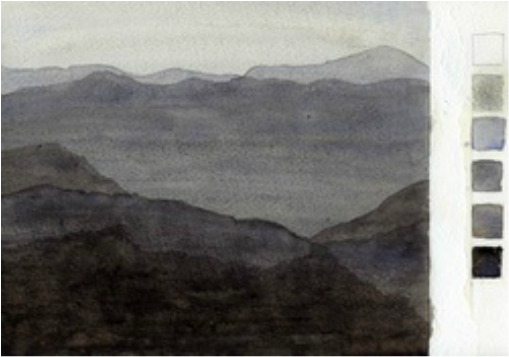From the exercise "Using tone to create aerial perspective"...
Q Why has the foreground has gone a bit "muddy"?
A This was caused by not giving the previous washes time to dry properly.
Ultramarine Blue and Burnt Sienna are both lifting colours and one needs to be especially careful when using them in glazes such as this. Often the paper appears to be dry when it is not. The surface may look dry but the watercolour washes have settled into the fibres of the paper meaning there will still be moisture within the paper.
Also, the paper that was used for this exercise is of inferior quality. Using inferior paper and paints only make the job of painting in watercolour more difficult. Making them a false economy.
Q Why did the two colours separate? I stirred them together in my palette before each application, as instructed!
A French Ultramarine and Burnt Sienna are notorious for this. Stirring well between applications is essential. They granulating colours made using heavy particles of pigment but they ought not to have separated to this extent.
On further examination I noticed that the French Ultramarine had dominated the mix. I asked my student whether "Artist quality" paints had been used, believing that the Burnt Sienna was "Student quality". Both the separation and the muddy effect would have been caused by the use of Student Quality paint. Student quality paint has less finely ground pigment and more fillers added to it and it is these qualities that make it so hard to handle. I was right, the Burnt Sienna was Student Quality.
Q Why doesn't my tone chart show better gradation?
A Well, I suspect that each square was painted and then the mix was altered in the actual exercise?
I would like to say though, that this is not an easy thing to get right. Please practice, because getting it right is essential in any kind of painting, but especially watercolour, as you only get one chance to achieve spontaneity in a watercolour painting. Squint to identify tonal variations, test your watercolour mix on a piece of paper which is the same make as the one you are using and remember that it will dry lighter. Only when you have the tone right should you go ahead and paint.
Thanks to my student for allowing me to use this exercise as an example on my blog. I'm sure many others will benefit from seeing it and hopefully it will give them courage to have a go too.
"Trial and error is better than no trial and no error".

 RSS Feed
RSS Feed